A Short Historical and Physical Description of Wythe County, Virginia
Showing all its Mineral, Agricultural and Commercial Resources and Prospects
Published by Order of Its Board of Supervisors for distribution at the Jamestown Ter-Centennial Exposition, 1907.
Compiled by H. M. Hauser, Wytheville
Wythe County
Is one of the garden spots of the Old Dominion, and is one of the oldest of the Southwestern tier of Counties. It was formed front Montgomery County in 1790 and named for Geo. Wythe, one of the signers of the Declaration of Independence.
It contains an area of almost 500 square miles, one twelfth of which is yet in virgin forest, with acres of fertile soil indifferently farmed; with mountains of ore and coal undeveloped, and with many unharnessed streams hurrying away to the sea. This region of Bluegrass hills and fertile valleys is one of marvelous beauty and of great possibilities.
It is traversed through the central part by the main line of the Norfolk & Western Railway Company, and on the south side of the County by its North Carolina and Speedwell extensions, making 75 miles of main line and 16 miles of side track in the County.
Wytheville, the County seat, is 270 miles front Richmond, 240 miles from Washington City, 335 miles front Norfolk, miles from Bristol and 80 miles from Roanoke.
Wythe County has over 60 miles of turnpike roads and 60 miles of macadamized roads, two local telephone lines and one long distance line, thus bringing every section into close touch.
Her population is 20,000 whites and 2,000 colored. The total valuation of property for 1906 was, land and improvements, $3, 267,017, personal property, $1,125,792, making a total of $4,392,709.
This is the valuation for purposes of taxation and is about only a third of its market value. But with this low valuation the rate of taxation thereon for State, County and District purposes will average about $1.25 upon each $100. The work animals and stock cattle and sheep were assessed in 1906 at nearly $300,000.
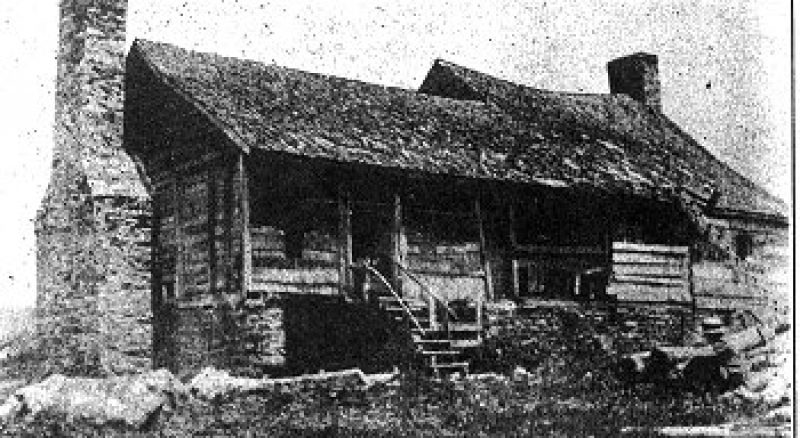
Topography
Wythe County lies in the Appalachian Division of the State, at an average elevation of 2200 feet above sea level.
Whilst more properly speaking it is a plateau region, it is also a prolongation of the Valley of Virginia, traversed by three mountain ranges generally running from northeast to southwest. The uplands its well as smooth bottoms are very productive. Some of the latter have a loamy soil five feet deep.
The mountains are rugged and broken, with several leaks nearly 4000 feet high. They are filled with abundant stores of mineral wealth and clothed with fine virgin forest.
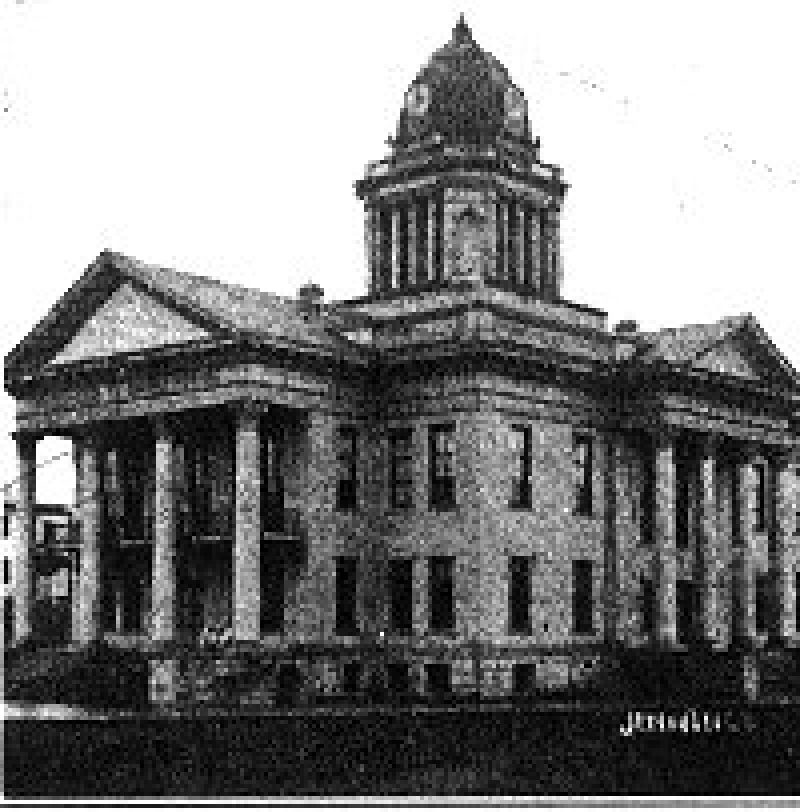
Soil.
Generally the soil is rather dark limestone though some is gray; and in the mineral belt. it is red. The mountain ridges are either sand or slate, all having a clay subsoil.
Geology.
Wythe County, from Southern to Northern border hold the rocks of nearly all the epochs and their sub-divisions: Huronian, Cambrian, Potsdam, Oriskany and Proto-Carboniferous. In nearly every era so represented Nature with a lavish hand has deposited some of her best told most useful ores. Alternating with each other on the south side are wonderful and extensive veins and deposits of iron, load, zinc, and manganese ores of extraordinary purity. Through the centre, red slates, shale, brown sand stones, limo stone find marble. While in the north will be found brown and semi-magnetic iron ores, lying close to workable veins of semi-bituminous and semi- anthracite coal. Lying between these belts and interlaced with them are fine belts of well watered grazing find fanning lands of a high order.
Within the limits of this county are an extent and variety of mineral and agricultural lands which taken together, are unsurpassed by the same area any where else in the United States.
Minerals.
The minerals of this County are immense if, quantity and value. They were known and worked in a primitive fashion 150 years ago and include lead, zinc, iron, manganese ores, coal, marble, limestone, soapstone, kaolin and sand. The southern part of the County, or the developed mineral belt, is dotted with the ruins of old charcoal furnaces, forges and smelting works. These have been supplanted by the immense hot blast furnaces of modern date now visible tit Austinville, Ivanhoe and Max Meadows.
Lead and Zinc.
These ores are found side by side through a considerable belt of this County and are of great value and purity.
Lead was first discovered at Austinville on New River, about 1750 by Col. Chiswell. He was a British officer who established Fort Chiswell a few miles distant in 1756. These mines have yielded lead and zinc almost continuously since their discover first utilized them in a very primitive manner. Some years later when Col. Chiswell was attending the “King’s Council” at Richmond, are gave such glowing accounts of the richness of his find that some arrogant wiseacre questioned his truthfulness. This precipitated a fight, in which, tradition says, Col. Chiswell slew his challenger with his sword.
At these same mines many bullets were moulded for the “Patriots of 1776.” Here our hardy mountaineers got the lead they used so successfully on Ferguson and his Redcoats at Kings Mountain. And they supplied the Southern Confederacy with nearly 5,000,000 pounds of its lead during, the Civil War.
The zinc is unsurpassed in quality, being the standard spelter of tile United States Government. Many specimens have shown by final analysis 96 per cent and 99 per cent. metallic zinc. Much zinc has been mined at Austinville and Bertha, but was carried to Pulaski City and other places to be smelted.
Many shafts have been worked also at Forneys, Ivanhoe and tit Cedar Springs in this County and surface indications appear at various places between these points.
Iron.
Iron ore being found in such profusion in Wythe County, it is not surprising to learn that David Peirce, an emigrant from Pennsylvania, made pig iron at his “Poplar Camp” furnace as early as 1779. The “Raven Clift” furnace was built in 1810, the “Little Wythe” in 1819, the “Cedar Run” in 1832, find from then until 1882 at least twelve more charcoal, cold-blast furnaces were, erected and operated, when the large hot blast ones cattle into vogue. Forges wore also erected at an early day in Wythe County. Among the first was that of David Peirce on Cripple Creek, near Ivanhoe, in about 1800. Prominent among the, others were Porter’s, Bell’s, Huddle’s and Chatwell’s. The largest and most successful, however, was that of David Graham, on Reed Creek, first built by him in 1828, tit what is still known as Graham’s Forge.
On the south side of the County, following the trend of Iron Mountain front cast to west, were a series of veins of what, it locally called Limonite Hematite and Mountain ores, of immense value, and extent. They show from 47 to 58 per cent. metallic iron. Some of the ore at Rich Hill, Ivanhoe and other points may be classed within the Bessemer standard. This section contains the old furnaces and forges find most of the modern ones, and cover miles of territory. The finest of charcoal iron has been made in this County as low as $9.00 per ton. The iron in Lick Mountain, Walker’s Mountain and Draper’s Mountain has not been so extensively developed, but shows from 45 to 54 per. cent. metallic iron. It reveals frequent and extensive deposits of semi-Magnetic Manganiferous and Oriskany iron ores, accompanied by drat system of rocks to which they geologically belong.
Coal.
Along the base of Little Walker’s Mountain, traversing the northern part of the County-and spreading considerably near Max Meadows, :ire outcrops of hard and soft coal in veins from 8 inches to 8 feet in thickness. ‘this has been but little developed although various openings ]rave been made, from time to time-to the north of Rural Retreat and Max Meadows and on Stony Foil. near Wytheville. The black smiths prefer this coal for their fires. It burns nicely in grates and some mined by Col. Boyd on Stony Fork some years before his death made a good quality of coke. At no point is this coal more than six miles from tire railroad. It will eventually occupy a more important position commercially than at present.
Manganese.
This ore is found in considerable quantities through the entire iron belt. Often combined with and again entirely distinct from the iron ore.
Copper.
Small veins and very fine specimen: have been found in the. County near Ivanhoe, Max Meadows and Mt. Airy, but it is not positively known to exist in and considerable quantity.
Marble.
Variegated marble is found generally through the County. Brown, red and almost white are also found. Upon Cripple Creek, to the north of Wytheville and north of Rural Retreat. It has not been extensively quarried because of the small local demand.
Kaolin and. Alumina
A considerable deposit of kaolin is found oil Lick Mountain, south of Wytheville as well as clay containing a high per cent. of alumina.
Limestone.
Exists in abundance in almost every section of the County. It is successfully used for lime, furnace fluxing, building purposes and for road metal.
For this reason cement works should succeed here.
Sandstone and. Sand.
Grindstone and whetstone rocks of good quality are abundant on Stony Fork of Reed Creek.
The granite-like sandstone of Sand Mountain always furnished the Hearth Rock for the charcoal furnaces, and there is an inexhaustible supply left.
Other sections of this mountain will furnish abundant material for glass-making.
Timber
The large boundaries on the south side of the County have generally been converted into charcoal by the furnaces. But they are still to be found. in the northern section of the County, containing white, red, black and chestnut oak, hickory, locust, maple, cedar, poplar, walnut, pine, ash and chestnut.

General Products.
Those articles generally raised in the Temperate Zone-whether belonging to the animal or vegetable kingdom-succeed in an admirable degree in this County, and bring good returns throughout the year.
Sonic of our citizens give special attention to stock raising; others to vegetables; others to fruit; others to poultry; others to bees, and so forth. The maximum yield of potatoes has been about 300 bushels per acre; of cabbage about 40,000 lbs.; front 35 to 55 bushels of wheat and from 60 to 100 bushels of corn to the acre. Of course the average is lower.
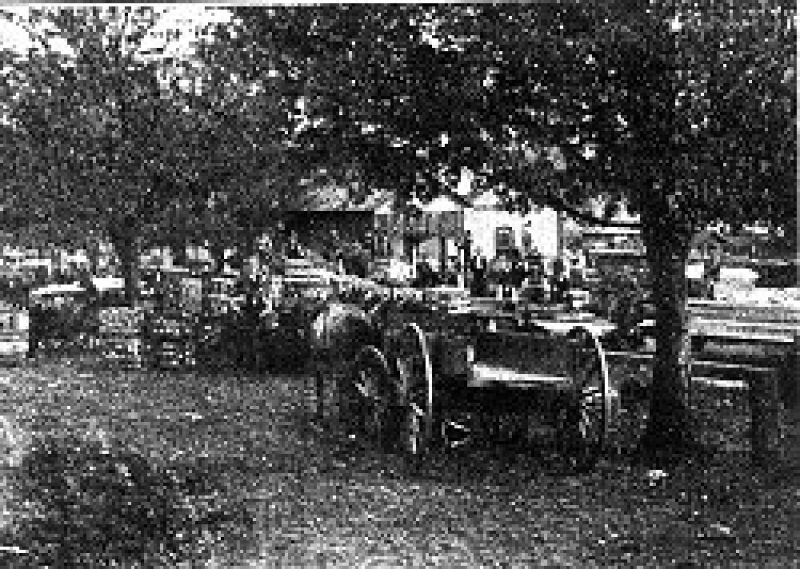
Tobacco, peanuts and sweet potatoes mature with its, but not to the same degree of perfection as in the Tidewater and Southside sections of tire state.
Asparagus and celery grow here to perfection. Much of our bottom lands will yield crops of celery as abundant as crisp, as fine flavored and with as good keeping qualities :is can be produced anywhere.
In many respect, the crops of 1906 were not up to the general average, but a few figures w ill serve to show tire variety and value of sortie staple products, of Wythe County. The following shipments were made front our depots last Year:
12,000,000 lbs. Cabbage or 600 car loads
200,000 bu. Potatoes or 400 car loads
300,000 bu Apples or 300 car loads
6,000 crates Eggs or 215,000 doz.
5,000 coops Poultry or 100,000 chickens
280,000 lbs. Dressed Fowls,
7 car loads Butter
5 car loads Onions,
25 car loads Live Hogs
250 car loads Cattle
120 car loads Sheep and Lambs.
This does not include hundreds of car loads of export logs, scores of car loads of tan bark, flour, feed stuff, wool and our various mineral waters.
The variety, the value and the quality of these products are elements of wealth, industry and prosperity that are not only present but perennial. Every summer shower reveals upon our hilltops that “everlasting covenant” which tells to each generation that seed time and harvest will return as long as the earth stands. The appetite of the Industrial World may in a few cycles consume our timber, and our ores; and so completely harness every unit of our water power that development along these lines will have passed the meridian of its prospects.
This can not be said of our farming, grazing and fruit crops. For as our soil is more scientifically and intensively handled, so will the quality and the quantity of its products increase with geometrical proportion.
There is stimulation and hope of bountiful harvests, large fruitage, and fat cattle being made more abundant each succeeding year. The zenith of Wythe County’s agricultural possibilities will come with the millennium.
Fruit.
Fruit deserves especial mention because in recent years some of our citizens have given marked attention to fruit culture in field and garden-and both with success. Fruits and berries raised here, in size, flavor, keeping and bearing qualities are second to none. Some new- orchards have already yielded crops bringing from $1500 to $3500 in the field.
Apples, pears, quinces, cherries, plums and grapes grow to perfection here. Peaches are also fine but not as sure. Strawberries, raspberries, currants and other similar small fruits arcs indigenous to our soil and yield luscious crops.
As our people become more familiar with their culture tire yield will of course be better. Thousands of trees are annually planted in this County.
Particular Industries.
The mining and manufacture of iron, lead and zinc is tit present very large. The iron furnace at Max Meadows has a daily output of nearly 200 tons and is one of the best equipped plants in the South. The iron furnace at Ivanhoe has a daily output of about 80 tons.
At Austinville, during the past three years, new and improved machinery to the value of $200,000 has been added to tire lead and zinc furnaces there. Iron ore is mined and washed at Patterson, Rich Hill, Barren Springs, Red Hill, Sanders, Tipton, Crawford, Foster Falls, Hematite, Locust Hill, Ivanhoe, Cripple Creek, Speedwell and perhaps other smaller places.
Large roller flour mills and large saw mills are found in every district.
Wagon factories, woolen mills, ice factories, foundry and machine strops, sash and blind factories and grain cradle factories supply a large part of our local demand for these things.
Produce dealers, stock raisin, fruit, poultry and dairy product., are each a large source of revenue.
Enterprising parties would do well here in the following lines of business:
Viz: Canning factories, wood working factories, cement works, fertilizer, brick and glass making. Any power plants needing motor power: Because, we have the needed raw material, and fuel supply so near. Because the local demand for these things is good, and being on the main line of a great Railway System the facility for distribution is good. Because the weather in favorable and the water is pure. And because our laborers arc generally intelligent and all speak the English language.
Water.
Pure, cool limestone and freestone springs exist in abundance. Some bold enough to run a corn – mill within 100 yards of their source.
Mineral springs are frequent and much used. viz: Bromide-Arsenic, Lithia, Chalybeate, Alum and Sulphur.
Climate.
The climate is delightful and invigorating for Wythe County’s altitude makes her people doubly blessed in that they are free from epidemics and mosquitoes. In temperature we are a happy mean between the rigors of the North and the humidity of the more Southern heat. Our summer nights are always cool enough for light covering. They are ideal for tourists or camping fishing parties.
The average temperature of Wytheville the County seat of Wythe County, for 33 years is as follows:
Summer 71 degrees
Winter 34 degrees.
As compared with Asheville, N. C., a noted resort 200 miles further south and with same elevation, about 2,300 feet, our annual average is only 1 degree colder, but we have one-fourth less fog, than Asheville.
As compared with, some famous European resorts, examine the following table:
| City | Summer | Winter | Year |
|---|---|---|---|
| Geneva | 70.3° | 34° | 52.7° |
| Vienna | 71.8° | 38.7° | 55.3° |
| Wytheville | 71° | 34° | 52.5° |
The following table shows for 33 years the monthly average of normal temperature and precipitation:
| Month | Temperature | Rainfall |
|---|---|---|
| January | 33° | 3.03″ |
| February | 35.1° | 3.38″ |
| March | 42.3° | 3.80″ |
| April | 52° | 3.05″ |
| May | 61.4° | 3.80″ |
| June | 68.7° | 4.20″ |
| July | 72.6° | 3.13″ |
| August | 70.5° | 4.51″ |
| September | 63.6° | 3.39″ |
| October | 53.6° | 2.74″ |
| November | 43° | 2.21″ |
| December | 35.3° | 2.77″ |
General average temperature per year, 52.6 degrees. Total of general average rainfall per year, 40.61 inches.
Education and Religion.
Our County has about 90 public schools enrolling something like 3600 pupils. Several have high-school departments for the more advanced students. Our school facilities and buildings are being improved each year. Besides these, there are a number of private schools of a high order.
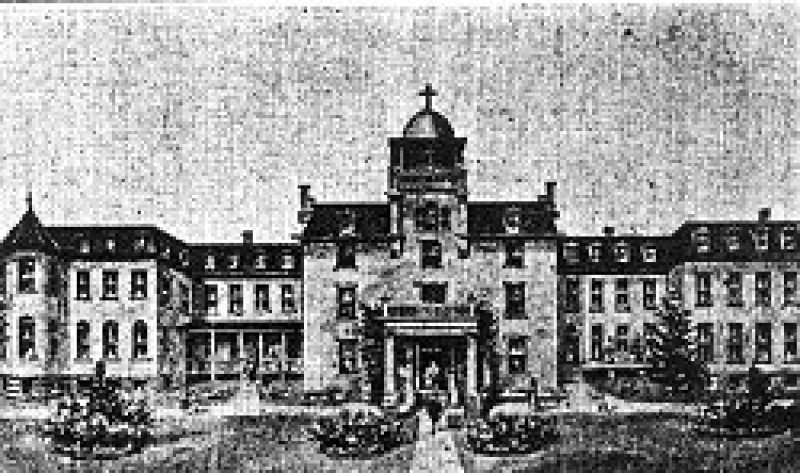
Her citizens are law-abiding, and grateful to Providence for the many spiritual and temporal blessings they enjoy. But few communities could be found in the State where there are more schools and churches than in Wythe County. There is not a single bar-room, distillery, or brewery in the County.
The following denominations are represented: Lutheran, Southern Methodist, Presbyterian, Baptist, Catholic, Episcopal, Christian and Northern Methodist among the whites; and the colored people are pretty evenly divided among Northern and Southern Methodist and Baptist.
Places of Interest.
During the summer months a large number of visitors make their borne in Wytheville. There are, numerous places of interest in the County to make their stay pleasant as well as healthful. There are innumerable place, aloe- the water courses or upon the mountains for picnic parties.
A drive to the farming country in any direction will rest you with an ever changing panorama of verdant slopes, fertile valleys, browsing cattle, blue mountains, sparkling streams, growing crops and busy men and women.
If you have a turn for mountain climbing, fishing, exploring or sight-seeing, you can easily put in the season. A trip to Chimney Rocks, on Lick Mountain, 4000 feet high and only 5 1/2 miles from Wytheville, will give you a glorious view of the northern and eastern part of the County.
Two miles east of the same mountain will be found a natural curiosity of considerable rarity. The Ant Hills, being several acres taken up by their immense heaps, in and out of which constantly pour millions of these voracious insects.
A trip to the U. S. Fish Hatchery will pay you.
There are several caves in the County.
Several old Indian burial grounds.
Then trips to the mineral section-to see the various mines, the furnaces, the modern machinery in contrast with the crumbling ruins of the primitive furnaces.
The old stone Shot Tower, at Jackson’s Ferry, on a bluff overlooking New River230 feet high, from the water level.
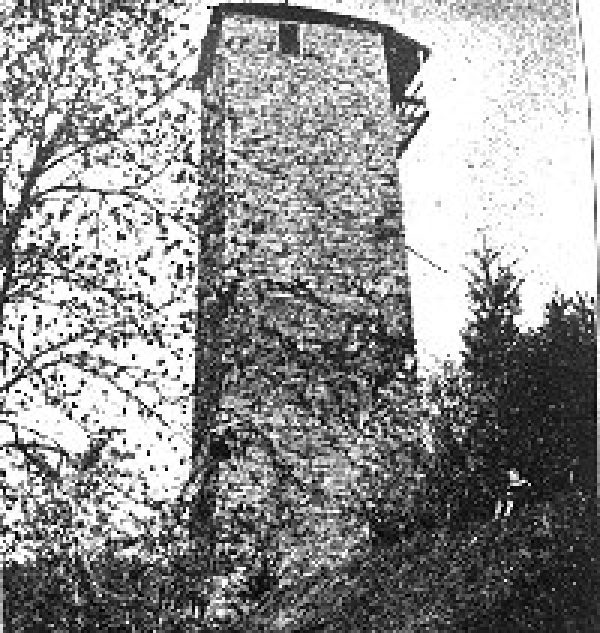
The Boiling Springs-where am entire creek gushes at once from the ground.
All of these places will charm you.
If you are a disciple of Isaak Walton, Cripple Creek, Reed Creek or New River will afford you abundant employment, for in these streams are the finest of game fish. Along their banks is scenery that rivals both Scotland and Switzerland.
Notable Incidents.
No great battle has been fought in Wythe County, nor has the accident of birth made it the home of a President.
Both Jefferson and .Jackson have visited our people in the days of the stagecoach. Whilst in the days of the pullman palace cars tire sturdy Cleveland and strenuous Roosevelt have both been delighted to see us viam.
The citizens of Wythe County are active, law-abiding and brave. The first settlers were English, Scotch-Irish, German, Irish and a few French.
For years it was a military out-post with a boundless hunter’s paradise to the west. From 1770 and for a quarter of a century afterwards, thousands of pioneers passed through here to Kentucky and Tennessee.
The old “Wilderness Road” from Draper’s Meadows to Cumberland Gap, often trodden by Boone and others, goes by Fort Chiswell and what is now Wytheville. Whilst the pioneer was contending with the red man, the tide of emigration bean to pour in and push to the west and southwest. 1n those stirring times our civilization began. From that day to the present Wythe County men have taken prominent part in developing the history of Virginia.
She was at Pt. Pleasant against Cornwallis, at King’s Mountain with Campbell and with Clark at Vincennes. During the war of 1812, her citizen, Gen. Alex. Smith defeated the British at Lake Erie. Among the captured stores at this encounter was a Dutch bell, cast in Hamburg which Gen. Smith brought home. A few years later he made Wythe County a present. of it and for more than 80 years it has hung in the Court-house and been used to announce the opening of court.
Wythe County sent many volunteers to the Mexican war also.
When the Civil war began in 1861, her gallant boys were among the first to the front. Every battle field from Manassas to Appomattox contains the remains of Wythe County soldiers. Our own cemetery holds the mortal remains of two generals who at different times commanded the immortal “Stonewall Brigade.” When this celebrated Brigade was first so named, in one of the regiments composing it, was more than one company of Wythe County men.
Wythe County, in all, furnished about 1500 men to the Confederacy, and none to the Federal army.
In the Spanish war, she sent one full company to the field. Many of these boys re-enlisted and have since served with distinction in the Philippines.
